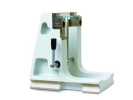ISO 179-2 Determination of Charpy Impact Properties - Instrumented
ISO 179-2 defines the method used to determine the resistance of plastic to breaking when impacted in a three point bend configuration, using a pendulum system with an appropriately sized, instrumented hammer arm. This test is used to characterize the materials behaviour under impact conditions. To this end, the instrumented hammer and Data Acquisition System collect relevant data in order to plot the force-deflection or force-time curve for the duration of the test. Different test parameters are specified according to the type of material that the specimen is made of as well as the type of notch cut in it. While similar to ASTM D6110 (Charpy Impact Resistance of Notched Plastic Specimens), the defined tests are significantly different and are not interchangeable.
To meet the requirements of the standard we recommend our CEAST 9050 Pendulum in either a manual or motorized version, along with a specimen support, properly sized shoulders, impact hammers, DAS (Data Acquisition System) and Visual Impact software. To get a full understanding of how the material will react to impact when exposed to sub-ambient temperatures, we recommend the inclusion of our Cryo Dispenser.
For specimen preparation we suggest the use of either our Motorized Notchvis or Automatic Notchvis, which together with the correct knife will allow the user to notch their samples correctly, according to the test standard.
To fully understand the test set-up, procedure, results and specimen preparation requirements, please refer to the standard that is available from the link below.
CEAST 9000 Series Pendulum Impact Series
Impact resilience is one of the most important properties and cost-effective evaluations for material producers, both with respect to product development and quality control. As components could fail at stress levels well below the critical fracture stress, accurate determination of impact damage propagation is necessary. With the combined experience of CEAST, Instron® has more than 50 years experience in designing pendulum impact testing systems.
- Products
- 09/12/2013
- 2.1 MB
Accessories for CEAST Impact Systems
Accessories for CEAST Drop Tower and Pendulum Impact Testers.
- Products
- 03/20/2013
- 1.71 MB
CEAST Data Acquisition and Analysis
The new CEAST DAS 64K is a state-of-the-art Data Acquisition System designed for impact testing instruments. Compatible
with the full range of CEAST impact testing systems, including pendulum type machines (CEAST 9000 Series) and drop towers (CEAST 9300 Series), it’s the key for instrumented impact testing. The DAS 64K also enables the data collection
from instrumented tups or hammers on older models and non-CEAST impact machines.
- Products
- 09/30/2013
- 519.99 KB





